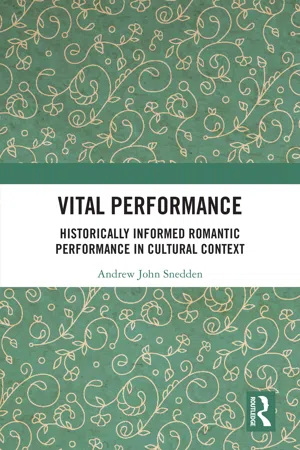
Vital Performance
Historically Informed Romantic Performance in Cultural Context
- 256 pages
- English
- ePUB (mobile friendly)
- Available on iOS & Android
About This Book
Historically Informed Performance, or HIP, has become an influential and exciting development for scholars, musicians, and audiences alike. Yet it has not been unchallenged, with debate over the desirability of its central goals and the accuracy of its results. The author suggests ways out of this impasse in Romantic performance style.
In this wide-ranging study, pianist and scholar Andrew John Snedden takes a step back, examining the strengths and limitations of HIP. He proposes that many problems are avoided when performance styles are understood as expressions of their cultural era rather than as simply composer intention, explaining not merely how we play, but why we play the way we do, and why the nineteenth century Romantics played very differently. Snedden examines the principal evidence we have for Romantic performance style, especially in translation of score indications and analysis of early recordings, finally focusing on the performance styles of Liszt and Chopin. He concludes with a call for the reanimation of culturally appropriate performance styles in Romantic repertoire.
This study will be of great interest to scholars, performers, and students, to anyone wondering about how our performances reflect our culture, and about how the Romantics played their own culturally-embedded music.
Frequently asked questions
Information
Part B
Reconstructing Romanticist performance style
4 Enigma
deciphering the past
4.1 Introduction: modes of knowing
- Romanticist values reflected in other arts and philosophies;
- Concert programmes, performance reports, performance etiquette reports (such as clapping, cheering, or jeering during performances), and types of performance spaces;
- Much critical writing on music, especially by Romanticist composers such as Berlioz, Schumann, Liszt, and Wagner;
- Many pedagogic tutors and lesson notes, most voluminously by students of Liszt; but also including much material from others, such as students of Chopin, Clara Schumann, and Leschetizky;
- The characteristics of period instruments, many now sensitively restored to good playing condition;
- Audio recordings beginning from the last decade of the C19th, in three distinct technologies (cylinders, phonograph disks, and reproducing piano and organ rolls).
4.2 Written evidence 1: linguistic problems
But from around 1900 treatises and teaching books on how to play and sing can be compared with recordings – often recordings of their authors … and what we find is devastating to the whole notion of historically informed performance. It would be impossible to come anywhere near the sounds people actually make by following only what they write. Documentary evidence now seems hopelessly insufficient without sound.2
And the same evidence has profound implications, too, for studies of scores, since their meanings appear to change far more quickly and radically than we could have supposed.3
The comparison between early recordings and contemporaneous written texts has exposed striking contradictions time and time again. … In fact, a style of performance based on the [verbal] advice alone would seldom approach the style of the recordings.4
In spite of its widespread use around the turn of the twentieth century, detailed contemporaneous written advice about annotated arpeggiation is somewhat scant. Many pedagogical texts fail to discuss it at all. Some consider it indispensable but describe it only in general terms or very briefly. Others advise its extremely judicious employment or absolute avoidance, branding it as a perfunctory device resulting in over sentimentality. [T]here is a significant gulf between written advice and practice.5
Table of contents
- Cover
- Half Title
- Title Page
- Copyright Page
- Dedication
- Table of Contents
- Music examples
- List of tables
- Foreword: Professor Geoffrey Lancaster AM
- Acknowledgements
- Introduction: the quest for nineteenth-century historical performance
- Part A Cultural and musical meaning
- Part B Reconstructing Romanticist performance style
- Concluding remarks – an unfinished journey
- Select bibliography
- Index